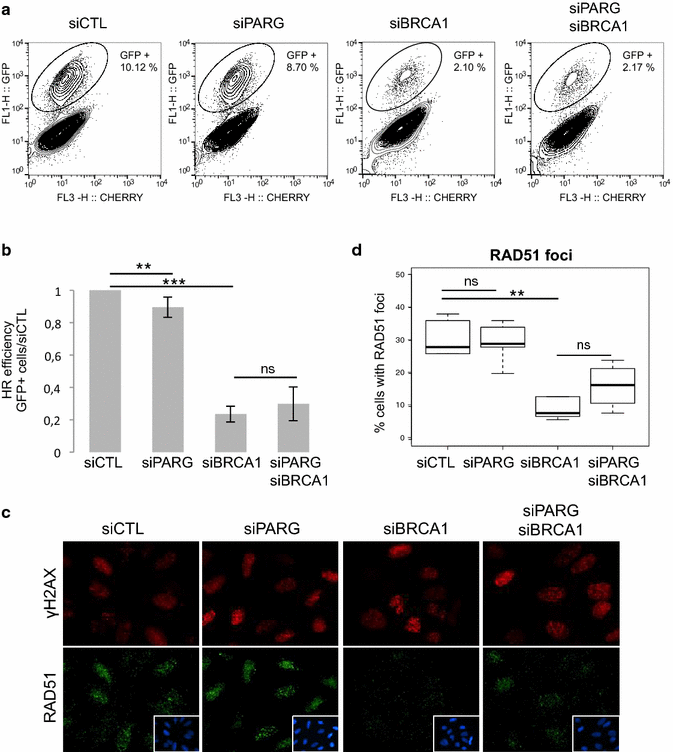PARG deficiency is neither synthetic lethal with BRCA1 nor PTEN deficiency
- PMID: 27375368
- PMCID: PMC4929728
- DOI: 10.1186/s12935-016-0333-2
PARG deficiency is neither synthetic lethal with BRCA1 nor PTEN deficiency
Abstract
Background: Poly(ADP-ribose) polymerase (PARP) inhibitors have entered the clinics for their promising anticancer effect as adjuvant in chemo- and radiotherapy and as single agent on BRCA-mutated tumours. Poly(ADP-ribose) glycohydrolase (PARG) deficiency was also shown to potentiate the cytotoxicity of genotoxic agents and irradiation. The aim of this study is to investigate the effect of PARG deficiency on BRCA1- and/or PTEN-deficient tumour cells.
Methods: Since no PARG inhibitors are available for in vivo studies, PARG was depleted by siRNA in several cancer cell lines, proficient or deficient for BRCA1 and/or PTEN. The impact on cell survival was evaluated by colony formation assay and short-term viability assays. The effect of simultaneous PARG and BRCA1 depletion on homologous recombination (HR) efficacy was evaluated by immunodetection of RAD51 foci and using an in vivo HR assay.
Results: The BRCA1-deficient cell lines MDA-MB-436, HCC1937 and UWB1.289 showed mild sensitivity to PARG depletion, whereas no sensitivity was observed for the BRCA1-proficient MDA-MB-231, MDA-MB-468, MCF10A and U2OS cell lines. However, the BRCA1-reconstituted UWB1.289 cell lines was similarly sensitive to PARG depletion than the BRCA1-deficient UWB1.289, and the simultaneous depletion of PARG and BRCA1 and/or PTEN in MDA-MB-231 or U2OS cells was not more cytotoxic than depletion of BRCA1 or PTEN only.
Conclusions: Some tumour cells displayed slight sensitivity to PARG deficiency, but this sensitivity could not be correlated to BRCA1- or PTEN-deficiency. Therefore, PARG depletion cannot be considered as a strategy to kill tumours cells mutated in BRCA1 or PTEN.
Keywords: BRCA; Cancer; Homologous recombination; Poly(ADP-ribose); Synthetic lethality.
Figures





References
LinkOut - more resources
Full Text Sources
Other Literature Sources
Research Materials
Miscellaneous

